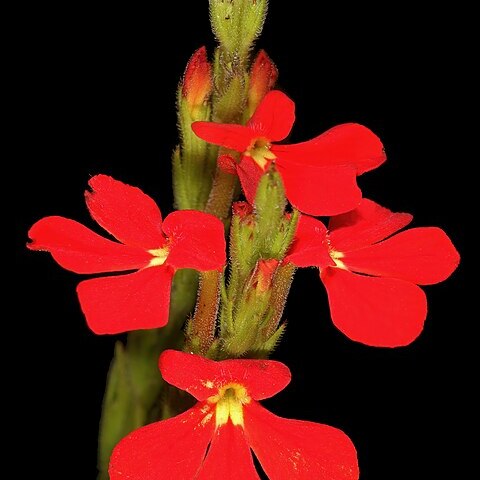Annual herb, parasite, 0.06-0.40 m; stem erect, branched, striate, leafy, hispid-scabrid. Leaves sessile, opposite or alternate, lanceolate-linear, erect, entire, scabridly pubescent, apex acute or pointed. Inflorescence a terminal, dense spike; flowers many, white, pink or crimson, sessile. Bracts lanceolate, acute, scabrid, hispid. Calyx narrow, hispid-scabrid; lobes lanceolate or subulate. Corolla subcylindrical, externally glandular-puberulous, internally pilose; tube enlarged and bent near apex; limbs spreading; lobes obovate, emarginate; upper lip broad. Stamens inserted above middle of corolla tube, glabrous. Flowering time Aug.-May.
Annual, hemiparasitic herb, up to 0.33 m high; green when dry, hispid-scabrid. Stems conspicuously harshly pubescent. Leaves with blade narrowly linear-ovate, ± 20 x 2 mm. Flowers: in opposite pairs, many out at a time; calyx with 10 or more ribs (nerves), at least 1 between each calyx tooth; corolla with tube glandular-puberulous outside, upper lip not much shorter than lower, red; Nov.-May.
Semiparasitic herb, up to 330 mm tall, green when dry, hispid-scabrid. Leaves entire, lanceolate-linear. Corolla tube glandular-puberulous outside, upper lip not much shorter than lower. Flowers red.
Corolla bright scarlet, yellowish outside, fragrant; tube c. 16 mm. long; limb upper lip bilobed, lower lip very deeply 3-lobed, about 1 cm. long.
Inflorescences terminal, 3–11(19) cm. long, usually rather dense or interrupted with several opposite pairs of flowers out at the same time.
Erect annual herb 11–36 cm. high, stems usually simple, densely strigose, when fresh yellowish green, drying greenish.
Slender, hairy, hemiparasitic perennial. Leaves linear. Flowers pink to red, lower lip enlarged, calyx 10-ribbed.
Lower bracts longer than calyx, upper ones shorter; bracteoles subulate, shorter than calyx.
Leaves mostly opposite, erect, 8–30(45) x 1–3 mm., linear, densely strigose.
Calyx 8–9 mm. long, including teeth, strigose.

